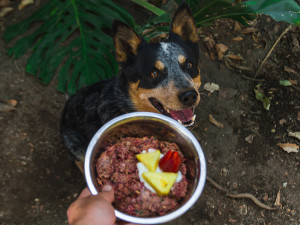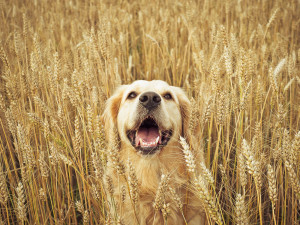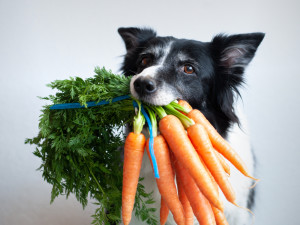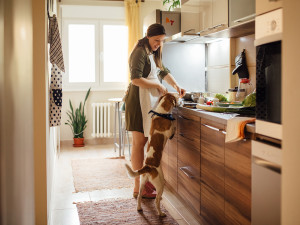How to Shop For Healthy, Eco-Friendly Ingredients to Feed Your Dog
From regenerative meats to low-carbon grains, these sustainable foods are fit for any conscious canine.

share article
Cooking is its own kind of love language, so it’s only natural for pet parents to want to whip up some homemade chow for their precious pups. Beyond being made with some good-ol’ TLC, homemade dog food tends to be less expensive and more customizable than what you’ll find in stores.
There are also sustainability reasons to consider making your own dog food: Pet food and treats make up the largest sales segment of the nearly $100 billion American pet industryopens in a new tab, and our cats and dogs now consume as much dietary energy as ~62 million humansopens in a new tab, almost one-fifth of the U.S. population. Cooking your pet’s food yourself allows you to choose ingredients that have a lower environmental impact, avoid energy-intensive processes like freeze-drying, and dodge pesky plastic packaging.
But there are some things you should know before turning your kitchen into an eco-friendly dog-feeding ground. For starters, fresh foods usually have a lower caloric density than kibble, so you’ll need to be diligent about packing them with all the fuel your pet requires. You’ll also want to be mindful of your dog’s food allergies, nutrition requirements, and individual health needs.
“The most important thing to remember is that, while home cooking can be a part of a healthy diet for a dog, it can also be easy to get it ‘ wrong,’” Dr. Emily Luisana, DVM, DACVIM, a clinical veterinary nutritionist at Friendship Hospital for Animalsopens in a new tab, tells The Wildest. For this reason, she always encourages people to consult with a board-certified veterinary nutritionist before introducing any homemade food into their pet’s diet, even if it’s just a meal here and there.
Once you have that professional blessing and guidance, here’s your buying guide for dog food ingredients that are as nutritiousopens in a new tab as they are sustainable.
Animal proteins:
“The best proteins are highly bioavailable and have an amino acid profile that meets dogs’ needs. These can include poultry such as chicken or turkey, pork, egg, and/or beef,” explains Dr. Luisana. But while meat proteins are healthy for your pup, they can be taxing on the planet. Livestock agriculture is a leading source of greenhouse gases in the U.S. — and protein-hungry dogs and cats contribute to a whopping 25–30 percent of its environmental impact, according to a 2017 UCLA research studyopens in a new tab.
Regenerative ranching is a technique for raising livestock in a way that uses the animal’s natural grazing patterns to restore soil health. Healthy soil is better equipped to trap and store the excess carbon humans have pumped into the atmosphere, making it an essential ally in the fight against climate change.
Buying tips: If you’re buying meat for your pet, source it from a company that is ROC certifiedopens in a new tab in regenerative organic agriculture like those in this directoryopens in a new tab.
Alternative proteins:
Another way to reduce the impact of your dog’s food is to give them proteins that wouldn’t get eaten otherwise. In the U.S., we only consume an average of 50-74% of an animal by weightopens in a new tab, while the rest of the bones and organs go to waste. Feeding these (often very healthy and nutrient-dense) leftover co-products to pets can keep them satiated and ease some of the strain on the livestock industry.
When searching for protein for your pup, you can also look beyond traditional animal sources. New innovations in sustainable pet foodopens in a new tab like insect treats, plant proteins, and lab-grown meats offer lower-impact alternatives to beef and poultry — though Dr. Luisana caveats that from a nutrition perspective, she’s cautious of “recommending a new protein source until its bioavailability, amino acid composition, and palatability are assessed on a large scale.”
Buying tips: Visit your local butcher for organ meats, and keep an eye on alternatives like Jiminy’sopens in a new tab crickets, Because Animalsopens in a new tab cultured meats, and Petalumaopens in a new tab plant proteins as they enter the market.
Carbohydrates:
In terms of global warming potential, not all carbs are created equal. Research shows that rice has a slightly higher carbon footprintopens in a new tab than other pet-friendly carbohydrate sources because of the amount of land and water it takes to grow. If your dog is a fan of oats, sorghum, or wheat, those tend to be more eco-friendly alternatives. Plus, you can buy them in bulk to avoid landfill-bound packaging.
Buying tips: Bring a few jars to the grocery store and get your pet’s oats, sorghum, wheat, and/or healthy seedsopens in a new tab from the bulk bin.
Fats, vitamins, and minerals:
Finally, fruits and vegetables are a wonderful source of the essential vitamins and mineralsopens in a new tab (not to mention antioxidants, fiber, and energy) that dogs need to feel their best. And while you may be choosy about what parts of produce you eat, your pup definitely isn’t. Fresh fruits and vegetables account for a combined 37% of the food we waste at homeopens in a new tab in the U.S.
So instead of throwing the peels, scraps, and ends of fruits and vegetablesopens in a new tab in the bin, incorporate them into your dog’s meals for a dose of nutrients that would have otherwise been wasted. Toss in some fat from plant-based hemp, flaxseed, or coconut oil and you have yourself a complete meal fit for a conscious canine.
Buying tips: Before buying new produce at the store, take a look at the edible scraps in your kitchen that can get repurposed into your dog’s food.

Emma Loewe
Emma is a writer, editor, and environmentalist based in New York City. She is the senior sustainability editor at mindbodygreen, the author of Return To Nature: The New Science of How Natural Landscapes Restore Us (April 2022), and the co-author of The Spirit Almanac: A Modern Guide To Ancient Self-Care. While she doesn’t have any pets of her own, she is a loving dog aunt to Pip the pup.
Related articles
![White terrier eating fresh dog food]() opens in a new tab
opens in a new tabThe Scoop on Human-Grade Dog Food
For starters, yes, it’s good enough to eat.
![A young woman giving her German Shepherd mixed breed dog scratches in her kitchen]() opens in a new tab
opens in a new tab3 Reasons to Cook Your Own Dog Food
DIYing meals is great for your pup’s health and your wallet.
![Pregnant woman cooks recipe in the kitchen with her dog]() opens in a new tab
opens in a new tabYou — Yes, You — Can Make Your Dog Homemade Chicken and Vegetables
Behold: the power of a home-cooked meal.
![A woman feeding food to her cat at a dining room table]() opens in a new tab
opens in a new tabIs Homemade Cat Food Better Than Kibble and Canned?
Integrative veterinarian Dr. Ruth Roberts on what ingredients to include when considering a home-cooked diet for your cat.
![Two dogs sitting behind the table]() opens in a new tab
opens in a new tabDog Food Recipes: Easy Crockpot Chicken & Brown Rice
A homemade family favorite.










